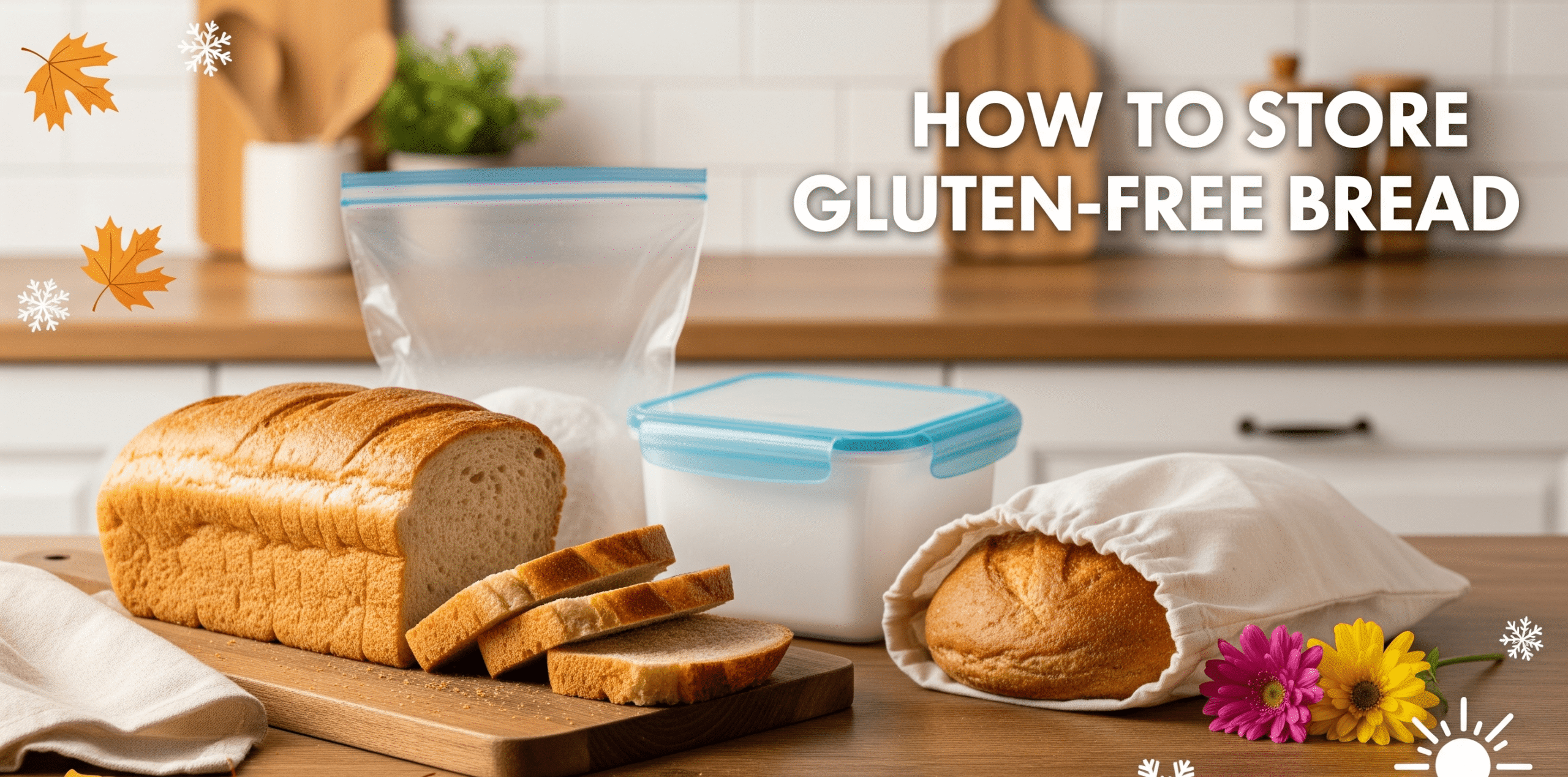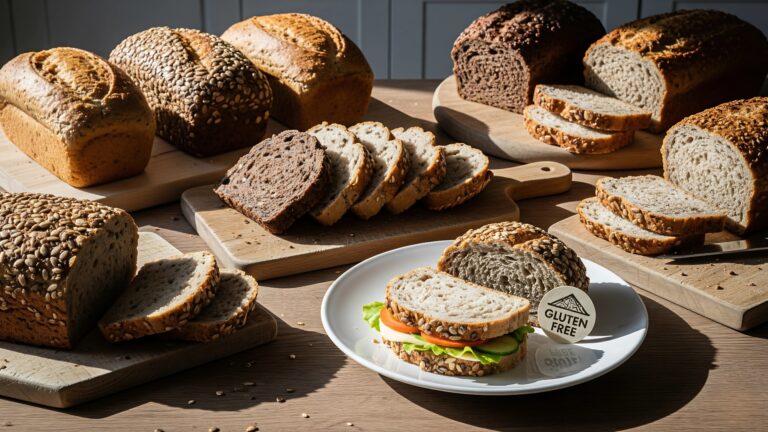How to Store Gluten Free Bread: The Complete Guide for Every Season
You might be thinking gluten-free bread is a miracle for celiacs or gluten-sensitive folks, but let’s be honest it’s pretty tough to keep it fresh. Whether you decide to make it yourself or pick it up from the supermarket, how to store gluten free bread so that it doesn’t become a brick (or a moldy disaster) is a question that every gluten-free consumer is pining over.
This definitive guide will dissect the optimal storage techniques for each season — winter, summer, spring, and autumn — so your bread remains fresh, flavorful, and set for those avocado toast or PB&J moments at GlutenFreeDietBook.
Also read – Gluten Free Recipe at Home: The Ultimate Collection for Every Craving
Why Is Storing Gluten-Free Bread Difficult?
Unlike regular bread, gluten-free bread does not contain the protein network (gluten) that provides structure and elasticity. That means it gets stale quicker and spoils much more easily. Throw in the absence of some preservatives in most gluten-free products, and you have got yourself a bread that requires proper TLC.

The Gluten-Free Bread Storage Essentials
Honestly before we decide to go into the season-by-season breakdown, here’s the general rulebook to remember:
- Avoid Room Temperature for Long-Term Storage: Gluten-free bread becomes stale very fast at room temperature unless you use it in 2-3 days.
- Freeze It, Don’t Refrigerate It: This bread despises the fridge, unlike your leftover food. It dehydrates too fast and loses its texture.
- Slice Before Freezing: Always slice first before you freeze so you can scoop what you need, when you need it.
How to Store Gluten Free Bread in Summer
The Challenge: Heat and Humidity
Summer is mold’s best friend. High temperatures and humidity can be used to convert your loaf into an overnight science experiment.
Tips and Best Practices:
- Store in Freezer: Freeze your bread slices in a plastic freezer bag. Double bag if your kitchen is particularly humid.
- Use Parchment Paper: Put parchment paper between slices to stop sticking.
- Thaw Right: Toast from frozen or thaw at room temperature for 15–20 minutes before using.
Pro Tip:
Leave a small amount (2-3 slices) out in an airtight container on the counter — eat within a day or two.
How to Store Gluten Free Bread in Winter
The Challenge: Dry Indoor Air
Although mold is not as big of an issue, dryness will dry out your bread.
Best Practices:
- Wrap Tightly: Wrap the loaf in plastic wrap and store it in an airtight container or zip bag to trap moisture.
- Freezer Works Here Too: Slice and freeze as in summer — freezing prevents drying out.
- Warm Before Use: Heat microwave for 15 seconds or toast lightly to restore softness.
Also read – How to Make Gluten Free Churros
So the question is How to Store Gluten Free Bread in Spring
The Challenge: Temperature Swings
Spring weather is unpredictable warm one day, cold the next. Moisture levels fluctuate, which is confusing to your bread.
Best Practices:
- Monitor Storage Area: Store your bread in a dark, cool pantry (not by a window or stove).
- Use Moisture-Control Packs: These absorb moisture in the container.
- Refrigerator? Not yet. Even if it’s raining continuously for days, don’t give in. Just don’t.
Also read – Symptoms of gluten intolerance vs celiac disease: Key Differences You Must Know
Also read – Gluten-Free Diet Plan for Weight Loss: 7-Day Meal Guide That Works
Also read – Gluten-Free Diet Benefits and Risks
How to Store Gluten Free Bread in Fall
The Challenge you may face is Cooler Temps, But Not Cold Enough
Fall can be lenient, but don’t slack off. Mold can still sneak in with indoor heat and warm afternoons.
Best Practices:
- Short-Term: Airtight Box: Place sliced bread inside an airtight container on the counter for 2 days maximum.
- Long-Term: Freeze Like a Pro: Your best option is always the freezer. Consistency prevails here.
- Label It: Always put the date you stored it — gluten-free bread keeps for 2–3 months max in the freezer.
Quick Storage Comparison
| Storage Method | Shelf Life | Texture Quality | Best For |
|---|---|---|---|
| Room Temperature | 1–2 days | Soft initially, then stale | Short-term use |
| Freezer | 2–3 months | Great when thawed or toasted | Long-term storage |
| Refrigerator | Not great | Bad, dehydrates quickly | Not at all recommended |
| Airtight Container (on Counter) | 1–2 days | Good | Short-term use |
Bonus Tips: Bread Storage Hacks
- Use a Bread Box: A contemporary bread box with air holes can regulate the moisture for short-term storage.
- Buy in Smaller Quantities: If you are not a large family, smaller loaves cut down on waste and storage hassle.
- Vacuum Seal for Long Freezer Life: Vacuum-sealing before freezing can increase freshness and avoid freezer burn.
- Add a Damp Paper Towel When Microwaving: Softens the slice and avoids dryness.
What About Homemade Gluten-Free Bread?
If you’re baking your own:
- Let it cool entirely before wrapping or freezing — warm bread = condensation = soggy bread.
- Use a linen or cotton bread bag for counter storage for 1 day.
- Slice only what you need, and freeze the rest right away.

Conclusion:
And finally you have it, the seasonal plan you never knew you needed for maintaining your gluten-free loaf fresh and fabulous. Whether you decide to bake it at home or swipe it off the grocery shelf, knowing how to store gluten free bread can be the difference between a great sandwich and a crouton-sized regret.
Follow these simple steps, be season-wise, and bid adieu to moldy mornings or difficult toast. Your gluten-free life just got a whole lot tastier.
Tip: Gluten-free bread is fragile, but with proper storage techniques, it will last longer and be more enjoyable to eat — season after season. Store it cool, store it sealed, and most of all, store it delicious!





